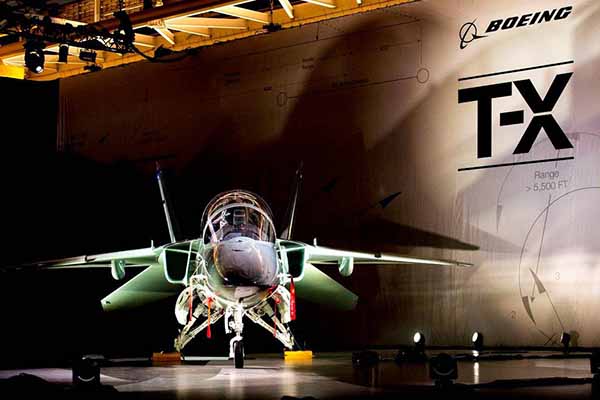Boeing on Tuesday revealed its candidate for the Air Force’s next trainer: a single-engine, twin-tailed aircraft made in a partnership with Swedish firm Saab.
After a dramatic rollout ceremony punctuated with dubstep music, flashing lights and a dropcloth unveiling of the plane, company executives dropped another bombshell: Boeing has already manufactured two of the jets.
“Our T-X design features: twin tails, a modern design that allows better maneuverability than a single tailed aircraft, stadium seating that provides rear visibility to the instructor … and a maintenance friendly design,” Darryl Davis, president of Boeing Phantom Works, said during the event. “Just as impressive is what you can’t see. What you can’t see is the advanced design and manufacturing that went into this.”
The Boeing-Saab trainer is powered by a single GE 404 engine made by General Electric and features a glass cockpit and open software that pushes data across the T-X jet and its associated ground training systems. The aircraft also has room for growth, Davis said. Although there is no requirement to put hard points on the wing, the jet can accommodate two per wing, and the company has also built in space for an aerial refueling receptacle.
The first aircraft, displayed during the rollout ceremony, has started ground testing and will fly by the end of the year, Davis said. The second aircraft, revealed to reporters after the rollout, will begin structural proof tests in the coming days that will evaluate the structural strength and integrity of the aircraft. Defense News accepted hotel and travel accommodations from Boeing.
Although the Air Force has incentivized certain performance elements, such as high G and high angle of attack, Davis explained that Boeing-Saab is hewing as closely to the threshold requirements as possible in an effort to drive costs down.
“We’re not going to talk about details of what we can do above the threshold requirements,” he said.
The companies are also relying on new manufacturing techniques, many of which they would not share with reporters. These processes enable Boeing to assemble the aircraft without any tools, Davis said. Other advances include improvements in adhesives that slash the time it takes to build the aircraft’s canopy and using 3-D printed polymer parts.
“I don’t want to give away all of the competitive secrets here,” he said. “But we’re going to shatter that cost curve.”
Davis would not detail the workshare agreement between Saab and Boeing, but said that much of the technology stems from Boeing’s F/A-18E/F Super Hornet and Saab’s Gripen.
“There’s a lot of reuse throughout this whole jet, to include some of the design and manufacturing,” he said. “They brought a tremendous amount of expertise, technical detail, a lot of reuse of some systems out of the Gripen.”

















